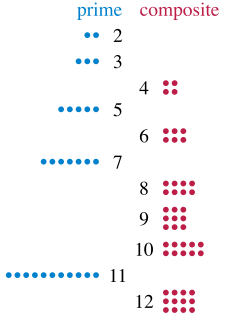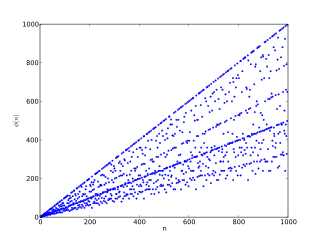A Zeisel number, named after Helmut Zeisel, is a square-free integer k with at least three prime factors which fall into the pattern
In mathematics, a square-free integer (or squarefree integer) is an integer which is divisible by no perfect square other than 1. That is, its prime factorization has exactly one factor for each prime that appears in it. For example, 10 = 2 ⋅ 5 is square-free, but 18 = 2 ⋅ 3 ⋅ 3 is not, because 18 is divisible by 9 = 32. The smallest positive square-free numbers are

where a and b are some integer constants and x is the index number of each prime factor in the factorization, sorted from lowest to highest. For the purpose of determining Zeisel numbers,  . The first few Zeisel numbers are
. The first few Zeisel numbers are

An integer is a number that can be written without a fractional component. For example, 21, 4, 0, and −2048 are integers, while 9.75, 5 1/2, and √2 are not.
- 105, 1419, 1729, 1885, 4505, 5719, 15387, 24211, 25085, 27559, 31929, 54205, 59081, 114985, 207177, 208681, 233569, 287979, 294409, 336611, 353977, 448585, 507579, 982513, 1012121, 1073305, 1242709, 1485609, 2089257, 2263811, 2953711, … (sequence A051015 in the OEIS ).
To give an example, 1729 is a Zeisel number with the constants a = 1 and b = 6, its factors being 7, 13 and 19, falling into the pattern

1729 is an example for Carmichael numbers of the kind  , which satisfies the pattern
, which satisfies the pattern  with a= 1 and b = 6n, so that every Carmichael number of the form (6n+1)(12n+1)(18n+1) is a Zeisel number.
with a= 1 and b = 6n, so that every Carmichael number of the form (6n+1)(12n+1)(18n+1) is a Zeisel number.
In number theory, a Carmichael number is a composite number which satisfies the modular arithmetic congruence relation:
Other Carmichael numbers of that kind are: 294409, 56052361, 118901521, 172947529, 216821881, 228842209, 1299963601, 2301745249, 9624742921, …
The name Zeisel numbers was probably introduced by Kevin Brown, who was looking for numbers that when plugged into the equation

yield prime numbers. In a posting to the newsgroup sci.math on 1994-02-24, Helmut Zeisel pointed out that 1885 is one such number. Later it was discovered (by Kevin Brown?) that 1885 additionally has prime factors with the relationship described above, so a name like Brown-Zeisel Numbers might be more appropriate.

A prime number is a natural number greater than 1 that cannot be formed by multiplying two smaller natural numbers. A natural number greater than 1 that is not prime is called a composite number. For example, 5 is prime because the only ways of writing it as a product, 1 × 5 or 5 × 1, involve 5 itself. However, 6 is composite because it is the product of two numbers that are both smaller than 6. Primes are central in number theory because of the fundamental theorem of arithmetic: every natural number greater than 1 is either a prime itself or can be factorized as a product of primes that is unique up to their order.
Hardy–Ramanujan's number 1729 is also a Zeisel number.
1729 is the natural number following 1728 and preceding 1730. It is known as the Hardy-Ramanujan number, after an anecdote of the British mathematician G. H. Hardy when he visited Indian mathematician Srinivasa Ramanujan in hospital. He related their conversation:
I remember once going to see him when he was ill at Putney. I had ridden in taxi cab number 1729 and remarked that the number seemed to me rather a dull one, and that I hoped it was not an unfavourable omen. "No," he replied, "it is a very interesting number; it is the smallest number expressible as the sum of two cubes in two different ways."
This page is based on this
Wikipedia article Text is available under the
CC BY-SA 4.0 license; additional terms may apply.
Images, videos and audio are available under their respective licenses.

In mathematics, the Fibonacci numbers, commonly denoted Fn form a sequence, called the Fibonacci sequence, such that each number is the sum of the two preceding ones, starting from 0 and 1. That is,

In number theory, the fundamental theorem of arithmetic, also called the unique factorization theorem or the unique-prime-factorization theorem, states that every integer greater than 1 either is a prime number itself or can be represented as the product of prime numbers and that, moreover, this representation is unique, up to (except for) the order of the factors. For example,

In number theory, the law of quadratic reciprocity is a theorem about modular arithmetic that gives conditions for the solvability of quadratic equations modulo prime numbers. Due to its subtlety, it has many formulations, but the most standard statement is:
In number theory, the Fermat pseudoprimes make up the most important class of pseudoprimes that come from Fermat's little theorem.

In number theory, a Gaussian integer is a complex number whose real and imaginary parts are both integers. The Gaussian integers, with ordinary addition and multiplication of complex numbers, form an integral domain, usually written as Z[i]. This integral domain is a particular case of a commutative ring of quadratic integers. It does not have a total ordering that respects arithmetic.

In number theory, Euler's totient function counts the positive integers up to a given integer n that are relatively prime to n. It is written using the Greek letter phi as φ(n) or ϕ(n), and may also be called Euler's phi function. It can be defined more formally as the number of integers k in the range 1 ≤ k ≤ n for which the greatest common divisor gcd(n, k) is equal to 1. The integers k of this form are sometimes referred to as totatives of n.
Fermat's little theorem states that if p is a prime number, then for any integer a, the number ap − a is an integer multiple of p. In the notation of modular arithmetic, this is expressed as

In mathematics, factorization or factoring consists of writing a number or another mathematical object as a product of several factors, usually smaller or simpler objects of the same kind. For example, 3 × 5 is a factorization of the integer 15, and (x – 2)(x + 2) is a factorization of the polynomial x2 – 4.
In mathematics a Fermat number, named after Pierre de Fermat who first studied them, is a positive integer of the form
A highly composite number, also known as an anti-prime, is a positive integer with more divisors than any smaller positive integer has. The term was coined by Ramanujan (1915). However, Jean-Pierre Kahane has suggested that the concept might have been known to Plato, who set 5040 as the ideal number of citizens in a city as 5040 has more divisors than any numbers less than it.
105 is the natural number following 104 and preceding 106.
In number theory, a formula for primes is a formula generating the prime numbers, exactly and without exception. No such formula which is efficiently computable is known. A number of constraints are known, showing what such a "formula" can and cannot be.
In number theory, Dixon's factorization method is a general-purpose integer factorization algorithm; it is the prototypical factor base method. Unlike for other factor base methods, its run-time bound comes with a rigorous proof that does not rely on conjectures about the smoothness properties of the values taken by polynomial.
The Beal conjecture is the following conjecture in number theory:
Euclid's theorem is a fundamental statement in number theory that asserts that there are infinitely many prime numbers. There are several proofs of the theorem.
Cubic reciprocity is a collection of theorems in elementary and algebraic number theory that state conditions under which the congruence x3 ≡ p (mod q) is solvable; the word "reciprocity" comes from the form of the main theorem, which states that if p and q are primary numbers in the ring of Eisenstein integers, both coprime to 3, the congruence x3 ≡ p is solvable if and only if x3 ≡ q is solvable.
A repeating or recurring decimal is decimal representation of a number whose digits are periodic and the infinitely repeated portion is not zero. It can be shown that a number is rational if and only if its decimal representation is repeating or terminating. For example, the decimal representation of 1/3 becomes periodic just after the decimal point, repeating the single digit "3" forever, i.e. 0.333…. A more complicated example is 3227/555, whose decimal becomes periodic at the second digit following the decimal point and then repeats the sequence "144" forever, i.e. 5.8144144144…. At present, there is no single universally accepted notation or phrasing for repeating decimals.
In mathematics, a Størmer number or arc-cotangent irreducible number, named after Carl Størmer, is a positive integer n for which the greatest prime factor of n2 + 1 is greater than or equal to 2n.











